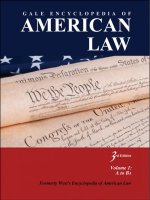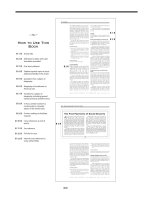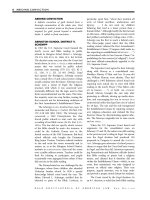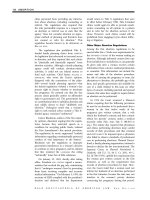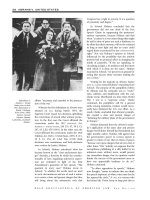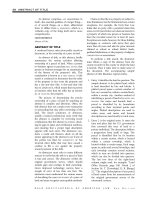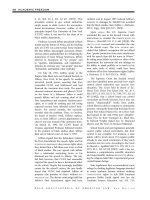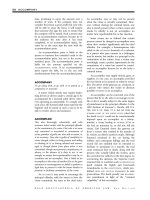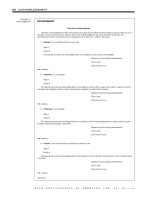Gale Encyclopedia Of American Law 3Rd Edition Volume 1 P6 ppt
Bạn đang xem bản rút gọn của tài liệu. Xem và tải ngay bản đầy đủ của tài liệu tại đây (330.23 KB, 10 trang )
An abstract comprises—or concentrates in
itself—the essential qualities of a larger thing—
or of several things—in a short, abbreviated
form. It differs from a
TRANSCRIPT, which is a
verbatim copy of the thing itself and is more
comprehensive.
CROSS REFERENCE
Abstract of Title.
ABSTRACT OF TITLE
A condensed history, taken from public records or
documents, of the ownership of a piece of land.
An abstract of title, or title abstract, briefly
summarizes the various activities affecting
ownership of a parcel of land. When a person
or business agrees to purchase
REAL ESTATE, that
person or business arranges for an examination
of the history of the property’s title. This
examination is known as a
TITLE SEARCH. A title
search is conducted to determine that the seller
of the property in fact owns the property and
has a free-and-clear title. A free-and-clear title
has no clouds on it, which means that no person
or business other than the seller has an interest
in, or
CLAIM to, the property.
The process of det ermining the precise
ownership of a piece of land by searching an
abstract is complex and laborious. Often, the
title abstract does not contain every transaction
or proceeding that may affect ownership of the
land. The search conductor, or abstractor,
usually a trained professional, must verify that
the abstract is complete by reviewing recent
certifications that the abstract is correct, check-
ing for gaps in dates and certification numbers,
and ensuring that a proper legal description
appears with each entry. The abstractor con-
ducts a credit and finances check on all the
names appearing in the abstract to see if any of
the parties has filed for
BANKRUPTCY or has
incurred other debts that may have caused a
creditor to file a
LIEN against the property
toward payment of the debt.
An abstractor must refer to many different
sources to verify that the title to a parcel of land
is true and correct. The abstractor verifies the
original government survey, which should
include gaps and overlaps in land ownership.
Given improved technology, surveys have a
margin of error of less than one foot. The
abstractor must understand the various means
of describing the exact
BOUNDARIES of a piece of
land and must recognize unacceptable methods.
Claims on the title to a property are subject to
time limitations, but the limitations have certain
exceptions. For example, the Forty-Year Law
holds that no party with a potential claim that
arose over 40 years before can claim an interest in
a property of which one person or business has
been the recorded owner for at least 40 years.
Exceptions are made, however, for those holding
mortgages or contracts with terms that span
more than 40 years and also for prior interests
claimed as school or school district lands,
parkland dedications, or the property of religious
CORPORATIONS or associations.
To perform a title search, the abstractor
must obtain a copy of the abstract from the
county recorder in the county in which the land
is located. Then it takes time to make sense of
the document. The accompanying sample
abstract of title illustrates typical entries.
1. Entry 1 identifies the land in question. The
sample abstract is for platted land, which
is land described by lots and blocks. A
platted parcel spans a certain number o f
feet, on a certain lot, within a certain block,
within a certain city. Another method of
identifying a parcel of land is by
METES AND
BOUNDS
. For metes and bounds land, a
parcel is identified by its boundaries
according to their terminal points and
angles. Platted descriptions are used in
urban areas, and metes and bounds
descriptions are used mostly in rural areas.
2. Entry 2 is the original entry. It states the
time and place that the U.S. government
first conveyed this tract of land to a
private individual. The description follows
a progression from small to large. The
parcel is identified first by its location
within a certain section, which is located
within a certain township, which is
located within a certain range. Each range
spans six miles and several townships, and
each township contains several sections,
which in turn are divided into quarters,
which can also be divided into quarters.
The last two lines of the right-hand
column might read, for example, “Land
Office Records, page 100. North
1
4
of
Section 36, T. [Township] 32, R. [Range]
22.” The original de scription of any parcel
of land comes from the measurements of
the original government survey of the
nineteenth cen tury.
GALE ENCYCLOPEDIA OF AMERICAN LAW, 3RD E DITION
38 ABSTRACT OF TITLE
3. Entry 3 is the land patent, or John Doe’s
title defense. The land patent is issued by
the government to operate as proof of title
for the first governmentally recognized
owner of the land. The land patent shows
the date of the land transfer, the date the
patent was filed with the government,
the particular book of deeds containing
the patent, and the land parcel as de-
scribed in the original entry.
4. Entry 4 reveals that John Doe platted his
quarter of section 36—that is, he subdivided
the land and dedicated it to the public for sale.
The beginning of the entry might read, “Plat
of Stoneybrook Addition to the City of New
Heidelberg.” Note that township 36 has
become, or has been incorporated into, what
is now New Heidelberg. The entry continues
with the date John Doe received approval
from the city of New Heidelberg, the date the
subdivision was filed with the county,
the particular book of plats in which the
subdivision is entered, and the original
description of the land. The subdivision is
entered in the county’s book of plats because
New Heidelberg has chosen to identify its
land parcels by plats, and not metes and
bounds. Other means of identifying land
parcels are sometimes employed. Land is
sometimes identified by acres in rural areas,
and by government lots for land adjacent to
meandering lakes, but most of the land in the
United States is identified by either plats or
metes and bounds.
5. Entry 5 shows that Joh n Doe sold a parcel
of the subdivision to Richard
ROE.Roe
received a
WARRANTY DEED, which serves as
evidence of Doe’s title. A warranty deed
means that Doe has warranted to Roe that
Doe is the rightful owner of the land. This
type of deed has legal ramifications that
benefit the purchaser, here Roe. There
are other types of real
ESTATE deeds. A
purchaser receives a
TAX DEED, for example,
when he or she buys real estate sold for
nonpayment of taxes, and this purchase
involves procedures that differ from those
of other land purchases. A sheriff’s deed
is given to the purchaser of land sold
by court order such as in a
MORTGAGE
FORECLO SU RE
, and this transaction also
has special legal ramifications for the
purchaser. Because the land in the sample
abstract is platted, the parcel i s assigned a
lot number, within a certain block, within
the city of New Heidelberg—for example,
this entry might read, “Lot 1, Block E,
Stoneybrook Addition to City of New
Heidelberg.” The entry also contains infor-
mation on when the warranty deed was
signed and when it was filed with the county.
6. Entry 6 shows that Richard Roe and Ruth
Roe have mortgaged their property to John
Smith. With an interest in lot 1 of block E as
COLLATERAL,SmithhaspaidfortheRoes’
property, and the Roes have undertaken to
repay Smith. The entry shows the date
the mortgage agreement was signed and
the date the mortgage was filed with the
county. The remainder might read, “Book 1
of Mortgages, page 10, to secure $10,000, due
January 10, 1910. Lot 1, Block E, Stoneybrook
Addition.”
7. Entry 7 shows that John Smith has
assigned the mortgage on lot 1, block E,
to William White. In other words, Smith
has sold to White his mortgagee interest in
lot 1, block E. An assignment can occur
for any number of reasons, but often it is a
sale made to satisfy debts. T his particu lar
action is entered in the book of assign-
ments in the county seat.
8. Entry 8 shows that Richard Roe and Ruth
Roe have paid off, or satisfied, the
mortgage (et ux is Latin for “and wife”).
This entry is filed in the book of assign-
ments in the county seat.
9. Entry 9 reveals that Richard Roe has died.
This “ Will and Probate” entry reports
that, u pon his death , Roe seeks to transfer
ownership of lot 1, block E, in New
Heidelberg, to his wife, Ruth Roe.
10. Entry 10 i dentifies Ruth R oe as the sole
owner of the parcel. The
PROBAT E court,
which tends to property matters sur-
rounding the death of an individual, has
approved the assignment of lot 1, block E,
contained in Richard Roe’s will.
11. Entry 11 shows that Ruth Roe has taken
out a mortgage on lot 1, block E. She has
borrowed money from Samuel Brown,
using the real estate as collateral. The
entry is identical to the first mortgage
agreement with John Smith, entry 6.
GALE ENCYCLOPEDIA OF AMERICAN LAW, 3RD E DITION
ABSTRACT OF TITLE 39
A sample abstract of title
Abstract of Title
11. Abstract of Title to north 500 feet, front and rear, of Lot 1 , Block 2 , in NW Addition to the City of New Heidelberg .
22. United States Entry No. 1 .
to Dated Jan. 1 , 1889.
John Doe. Land Office Records, page 100 .
North 1/4 of Section 36 , T. 32 , R. 22 .
23. United States Patent.
to Dated Jan. 1, 1889 .
John Doe Filed Jan. 1, 1889 .
Book 1 of Deeds, Page 100 .
North 1/4 of Section 36 , T. 32 , R. 22 .
14. John Doe et al. Plat of Stoneybrook E Addition to the City of New Heidelberg .
to Dated Feb. 1, 1889 .
The Public. Filed Feb. 1, 1889 .
Book 1 of Plats, page 200 .
North 1/4 of Section 36 , T. 32 , R. 22 .
25. John Doe, unmarried, Warranty Deed.
to Dated Feb. 1, 1890 .
Richard Roe. Filed Feb. 1, 1890 .
Book 3 of Deeds, page 300 .
Lot 1 , Block E , Stoneybrook Addition to City of New Heidelberg .
26. Richard Roe and Mortgage.
Ruth Roe, his wife, Dated Feb. 1, 1890 .
to Filed Feb. 1, 189
0 .
John Smith. Book 1 of Mortgages, page 10 , to secure $10,000 , due
January 10, 1910 .
Lot 1 , Block E , Stoneybrook Addition.
27. John Smith Assignment of Mortgage No. 6.
to Dated Jan. 1, 1895 .
William White Filed Jan. 1, 1895 .
Book 5 of Assignments, page 100 .
28. William White Satisfaction of No. 6.
to Dated Jan. 1, 1910 .
Richard Roe et ux. Filed Jan. 1, 1910 .
Book 3 of Satisfactions, page 200 .
29. Richard Roe Will and Probate.
to Dated July 1, 1915 .
Ruth Roe Probate July 1, 1915 .
Filed Aug. 1, 1915 .
Book 10 of Miscellaneous, page 100 .
Testator leaves all of his property, real and personal, to his wife, Ruth Roe.
10. Richard Roe Final Decree.
to Probate Court, Munich County.
Ruth Roe Dated Aug. 1, 1915 .
Filed Aug. 1, 1915 .
Book 10 of Miscellaneous, page 300 .
Adjudged and decreed that Lot 1 , Block 2 , NW . Addition is
hereby assigned to Ruth Roe.
11. Ruth Roe, widow, Mortgage.
to Dated Jan. 1, 1920 .
Samuel Brown. Filed Jan. 1, 1920 .
Book 10 of Mortgages, page 100 , to secure $20,000 , due
Jan. 1, 1930 .
Lot 1 , Block 2 , NW Addition.
12. Ruth Roe, widow, Foreclosure of No. 11.
by Sheriff of Notice of sale, Feb. 1, 1930.
County, Affidavit of publication, Feb. 1, 1930
to Proof of service, Feb. 1, 1930.
Samuel Brown. Sheriff's certificate of sale, March 1, 1930.
Filed March 1, 1930.
Book 15 of Miscellaneous, page 300 .
Lot 1 , Block 2 , NW Addition, sold March 1, 1930, to
Samuel Brown, for $10,000 .
[continued]
GALE ENCYCLOPEDIA OF AMERICAN LAW, 3RD E DITION
40 ABSTRACT OF TITLE
12. Entry 1 2 reveals that Ruth Roe was unable
to make her mortgage payments to Samuel
Brown, and Brown has sought payment by
exercising his right to force a sale of the
property by foreclosing on the mortgage.
The
FORCED SALE was published in a
newspaper. The dates of public notice,
the publication
AFFIDAVIT, and the service
of notice to Roe are all entered in the
abstract. The certificate of sale and
the date the forced sale was filed with the
county are also included. This entry shows
that Brown has purchased lot 1 at the
resulting sheriff’s sale of the property.
The amount Brown paid would depend on
the value of the real estate and the amount
of the mortgage. The “No. 11” following
“Foreclosure of” simply refers to the court
document number of the foreclosure.
13. Entry 13 shows that Samuel Brown and
Sophy Brown have sold a part of lot 1 to
James Jones by
QUITCLAIM DEED. Generally,
a quitclaim deed transfers title to property
without warranties that the title is free and
clear. Owing to Ruth Roe’s financial
troubles, the Browns are probabl y uncer-
tain of their title’s completeness, so they
have chosen to sell parts of their lot by
quitclaim deed instead of warranty deed.
Jones now owns a northern piece of lot 1,
block E, of Stoneybrook Addition.
14. Entry 14 shows the taxes paid on the
property, except for the current year. An
entry of taxes paid is listed every time a tax
ASSESSMENT is made or paid in relation to
the property of the abstract. Taxes listed in
the abstract may include estate taxes,
inheritance taxes, capital gains taxes, and
local government property taxes. The
abstract should include the current
amount of these taxes and certification
that they have been paid.
15. Entry 15 reveals that, to avoid financial
disaster, James Jones has filed bankruptcy.
The northe rn piece of lot 1, block E,
Stoneybrook Addition, New Heidelberg, is
now being used to secure protection from
creditors. Jones has given to the bank-
ruptcy court a
TRUST DEED,whichthecourt
retains until Jones has fulfilled his obliga-
tions under the financial rehabilitation
plan approved by the court. Should Jones
default on this arrangement, the court
could order a forced sale of the property,
with proceeds going to Jones ’s creditors.
The land covered by this particular
abstract has now been defined; it is a
certain northern piece of lot 1 of block E
in the Stoneybrook Addition of New
Heidelberg. The land to the south of this
piece would h ave its own abstract, which
would be identical to this abstract up to
the point that lot 1 was divided up and
part of it sold to Jones. Likewise, the
abstract for the adjacent lot 2 on block E
would have an abstract identical to this
abstract up to the point that John Doe sold
to Richard Roe the ne wly platted land of
section 36 in township 32, range 22.
FURTHER READINGS
Galaty, Fillmore, Wellington J. Allaway, and Robert C. Kyle.
2002. Modern Real Estate Practices. 16th ed. Chicago:
Dearborn Real Estate Education.
Jacobus, Charles J. 1998. Real Estate Law. 2d ed. Florence,
KY: South-Western Education.
Koenig, R. Harry. 1991. How to Lower Your Property Taxes.
New York: Fireside.
Abstract of Title
13. Samuel Brown and Quitclaim Deed.
Sophy Brown, his wife, Date April 1, 1940 .
to Filed April 1, 1940 .
James Jones. Book 27 of Deeds, page 100 .
North 250 feet, front and rear, of Lot 1 , Block 2 ,
NW Addition.
14. Taxes paid, except for year 1940, amounting to $15,000.
15. In re James Jones Petition of Debtor for arrangement under Chapter XI of the Bankruptcy Act,
Bankruptcy as amended (§ 301 et seq.) filed Jan. 1, 1950 in U.S. District Court for
No. the District of New Hampshire.
A sample abstract of title
(continued)
ILLUSTRATION BY GGS
CREATIVE RESOURCES.
REPRODUCED BY
PERMISSION OF GALE,
A PART OF CENGAGE
LEARNING.
GALE ENCYCLOPEDIA OF AMERICAN LAW, 3
RD E DITION
ABSTRACT OF TITLE 41
CROSS REFERENCES
Deed; Property Law; Real Property; Recor ding of Land
Titles; Tor rens Title System.
ABSTRACTION
Taking from someone with an intent to injure or
defraud.
Wrongful abstraction is an unauthorized
and illegal withdrawing of funds or an
APPROPRI-
ATION
of someone else’s funds for the taker’s
own benefit. It may be a crime under the laws of
a state. It is different from embezzlement, which
is a crime committed only if the taker had a
lawful right to possession of the money when it
was first taken.
ABUSE
Everything that is contrary to good order estab-
lished by usa ge. Departure from reasonable use;
immoderate or improper use. Physical or mental
maltreatment. Misuse. Deception.
To wrong in speech, reproach coarsely, dispar-
age, revile, and malign.
ABUSE EXCUSE
Description of efforts by some criminal defendants
to negate criminal responsibility by showing
that they could not tell right from wrong due to
abuse by their spouses or parents. Although this
defense is not specifically recognized in substantive
criminal law, it has been used successfully in some
cases to prove, for example, the insanity defense.
Using prior sex ual or other physical abuse as
evidence in a criminal defense is largely a result
of research regarding mental disorders caused
by such abuse. Psychologists and other
researchers have identified disorders, including
post-traumatic stress disorder and battered
woman syndrome, as causes for severe emo-
tional instability that can lead to violent acts by
the victim against his or her abuser. Some
writers have advocated more widespread use of
such evidence to mitigate the
PUNISHMENT of
victims who commit violent acts.
Other scholars and writers disagree, noting
that substantive
CRIMINAL LAW does not recognize
the
ABUSE EXCUSE as a legitimate defense except in
some limited circumstances, such as those
involving the
INSANITY DEFENSE. Harvard law
professor
ALAN DERSHOWITZ coined the term in
his 1994 book, The Abuse Excuse, where he
deems the studies regarding psychological
disorders caused by abuse as “psychobabble”.
Dershowitz and other critics disagree not only
with the use of abuse as mitigating evidence of
criminal intent, but also with the results of the
studies themselve s. According to these critics,
especially Dershowitz, the abuse excuse fails to
distinguish between the reasons why a person
committed a crime and the responsibility for
committing the crime.
In a few high profile cases during the late
1980s and 1990s, defendants sought to avoid
criminal responsibility for their crimes by
introducing evidence of prior abuse. In 1989
Lyle and Erik Menendez, ages 21 and 18
respectively, brutally killed their parents in the
family’s California home. At their first trial for
MURDER in 1993, the brothers’ defense team
introduced evidence that the men’s father, Jose
Menendez, had sexually abused his sons for a
number of years. Because of this abuse, Lyle and
Eric, according to the defense, killed their parents
out of fear. In raising the evidence of abuse, the
defense sought to reduce the conviction from
murder to voluntary
MANSLAUGHTER. The defense
won a victory of sorts when the first trial ended in
a
HUNG JURY because the jurors could not agree
whether the brothers were killers or whether they
acted out due to the years of alleged abuse they
had suffered. In a second trial in 1995, however,
the jury convicted the brothers of first-degree
murder notwithstanding the evidence of abuse,
and the judge sentenced them to life in prison
without the possibility of
PAROLE.
In 1993 Lorena Bobbitt was indicted for
MALICIOUS wounding after cutting off her sleeping
husband’s penis during the middle of the night.
At her trial, her defense team introduced
evidence of a history of sexual and physical abuse
committed by the husband, John, against Lorena.
Unlike the Menendez case, where the defense
conceded that the brothers were criminally
responsible for their actions, Lorena’s defense
team used the evidence to prove the insanity
defense. In 1994 a jury found her not guilty of
the crime by reason of insanity.
Scholars have noted that the employment of
the abuse excuse as a defense is more viable if
it is used to prove insanity, which happened in
the Lorena Bobbitt case. Commentators have
also noted that evidence of prior abuse, whether
substantiated or not, has been used in settings
other than criminal defense. For instance, a wife
may accuse a husband of
SEXUAL ABUSE during
GALE ENCYCLOPEDIA OF AMERICAN LAW, 3RD E DITION
42 ABSTRACTION
DIVORCE proceedings or an adult woman may SUE
her father for sexual abuse that allegedly
occurred when the woman was a child.
FURTHER READINGS
Arenella,Peter.1996.“Demystifying the Abuse Excuse: Is
There One?” Harvard Journal of Law and Public Policy 19.
Becker, Mary E. 1998. “The Abuse Excuse and Patriarchal
Narratives.” Northwestern Univ. Law Review 92, vol. 4.
Dershowitz, Alan M. 2000. “Review Essay: Moral Judgment:
Does the Abuse Excuse Threaten Our Legal System?”
Buffalo Criminal Law Review 3, vol. 2.
ABUSE OF DISCRETION
A failure to take into proper consideration the
facts and law relating to a particular matter; an
arbitrary or unreasonable departure from prece-
dent and settled judicial custom.
Where a trial court must exercise discretion
in deciding a question, it must do so in a way
that is not clearly against logic and the evidence.
An improvident exercise of discretion is an
error of law and grounds for reversing a
decision on
APPEAL. It does not, however,
necessarily amount to
BAD FAITH, intentional
wrong, or misconduct by the trial judge.
For example, the traditional standard of
APPELLATE review for evidence-related questions
arising during trial is the “abuse of discretion”
standard. Most judicial determin ations are
made based on evidence introduced at
LEGAL
PROCEEDINGS
. Evidence may consist of oral
TESTIMONY, written testimony, videotapes and
sound recordings,
DOCUMENTARY EVIDENCE such
as exhibits and business records, and a host of
other materials, including voice exemplars,
handwriting samples, and blood tests.
Before such materials may be introduced into
the record at a legal proceeding, the trial court must
determine that they satisfy certain criteria govern-
ing the admissibility of evidence. At a minimum,
the court must find that the evide nce offered is
relevant to the legal proceedings. Evidence that
bears on a factual or legal issue at s take in a
controversy is considered relevant evidence.
The relevancy of evidence is typically
measured by its
PROBATIVE value. Evidence is
generally deemed probative if it has a tendency
to make the existence of any material fact
more or less probable. Evidence that a
MURDER
DEFENDANT
ate spaghetti on the day of the murder
might be relevant at trial if spaghetti sauce w as
found at the murder scene. Otherwise such
evidence would probably be deemed irrelevant
and could be excluded from trial if opposing
counsel made the proper objection.
During many civil and criminal trials, judges
rule on hundreds of evidentiary objections lodged
by both parties. These rulings are normally snap
judgments made in the h eat of battle. Courts
must make these decisions quickly to keep the
proceedings moving on schedule. For this reason,
judges are given wide latitude in making
evidentiary rulings and will not be overturned
on appeal unless the appellate court finds that the
trial judge abused his or her discretion.
For example, in a
NEGLIGENCE case, a state
appellate court ruled that the trial court did not
ABUSE its discretion by admitting into evidence a
posed accident-scene photograph, even though
the photograph depicted a model pedestrian
blindly walking into the path of the driver’s
vehicle with the pedestrian’s head pointed
straight ahead as if she was totally oblivious to
the vehicle and other traffic (Gorman v. Hunt, 19
S.W.3d 662 [Ky. 2000]). In upholding the trial
court’s decision to admit the evidence, the
appellate court observed that the photograph
was only used to show the pedestrian’s position
relative to the vehicle at the time of impact and
not to blame the pedestrian for being negligent.
The appellate court also noted that the
LAWYER
objecting to the photograph’sadmissibility
was free to remind the jury of its limited relevance
during
CROSS-EXAMINATION and closing arguments.
An appellate court would find that a trial
court abused its discretion, however, if it
admitted into evidence a photograph without
proof that it was authentic (Apter v. Ross, 781 N.
E.2d 744 [Ind.App. 2003]). A photograph’s
authenticity may be established by a witness’s
personal observations that the photograph accu-
rately depicts what it purports to depict at the
time the photograph was taken. Ordinarily the
photographer who took the picture is in the best
position to provide such testimony.
FURTHER READINGS
Cohen, Ruth Bryna. 2000. “Superior Court Affirms Non Pros
for Failure to Subpoena Own Witness; Trial Court Did
Not Abuse Discretion in Its Application of Civil Procedure
Rule 216.” Pennsy lvania L aw Week ly (October 9).
Hamblett, Mark. 2001. “Circuit Panel Issues Recusal
Guidelines; Says Rakoff Acted Properly In Not Stepping
Down.” New York Law Journal (February 26).
Riccardi, Michael A. 2002. “Polygraph Evidence OK to
Prove Probable Cause, Circuit Judges Say; No Abuse of
Discretion in Relying on ‘Lie Detector’ for Limited
Purpose.” Pennsylvania Law Weekly (April 29).
GALE ENCYCLOPEDIA OF AMERICAN LAW, 3RD E DITION
ABUSE OF DISCRETION 43
CROSS REFERENCES
Appeal; Bad Faith; Error; Evidence; Precedent; Probative;
Relevancy.
ABUSE OF POWER
Improper use of authority by someone who has that
authority because he or she holds a public office.
ABUSE OF POWER is different from usurpation
of power, which is an exercise of authority that
the offender does not actually have.
ABUSE OF PROCESS
The use of legal process to accomplish an unlawful
purpose; causing a summons, writ, warrant,
mandate, or any other process to issue from a
court in order to accomplish some purpose not
intended by the law.
For example, a grocer rents a small building
but complains to the
LANDLORD about the
inadequate heating system, leaks in the roof,
and potholes in the driveway. When the
landlord fails to make the required repairs, the
grocer decides the property is worth less and
deducts $100 a month from his rent payments.
The landlord starts a lawsuit to either recover
the full amount of rent due or to oust the grocer
and regain possession of the premises. The law
in their state is fairly clear on the question:
A tenant has no right to force a landlord to
make repairs by withholding a portion of the
rent. The landlord knows that she has a good
chance of winning her case, but she also wants
to teac h the grocer a lesson. On the first three
occasions that the case comes up on the court
calendar, the grocer closes his store and appears
in court, but the landlord does not show up. On
the fourth occasion, the landlord comes to court
and wins her case. The grocer, in a separate
action for
ABUSE OF PROCESS, claims that the
landlord is using the court’s power to order him
to appear simply to harass him. The court
agrees and awards him money damages for lost
income and inconvenience.
Abuse of process is a wrong committed
during the course of
LITIGATION. It is a perversion
of lawfully issued process and is different from
MALICIOUS PROSECUTION, a lawsuit started witho ut
any reasonable cause.
ABUSIVE
Tending to deceive; practicing abuse; prone to ill-
treat by coarse, insulting words or harmful acts.
Using ill treatment; injurious, improper, hurtful,
offensive, reproachful.
Using
ABUSIVE language, even though offen-
sive, is not criminal unless it amounts to
fighting words that, by their very utterance,
tend to incite an immediate
BREACH OF THE PEACE.
ABUT
To reach; to touch. To touch at the end; be
contiguous; join at a border or boundary; terminate
on; end at; border on; reach or touch with an end.
The term abutting implies a closer proximity than
the term adjacent.
When referring to real property, abutting
means that there is no intervening land between
the abutting parcels. Generally, properties that
share a common boundary are abutting. A statute
may require abutting owners to pay proportional
shares of the cost of a street improvement project.
v
ABZUG, BELLA SAVITSKY
Bella Savitsky Abzug served as a Democratic
congresswoman in the 1970s and became one of
the most outspoken advocates for women’s
rights in the United States. After she left
Congress in 1976, she remained involved in
political and social issues both nationally and
internationally. With her raspy voice, New York
accent, and trademark floppy hat, Abzug was
one of the most recognizable public figures in
recent U.S. history.
Bella Savitsky was born on July 24, 1920, in
New York City and was raised in the Bronx. The
daughter of Russian immigrant Jews, her father
was a butcher who operated the “Live and Let
Live” meat market. As a young girl, she raised
and collected money on behalf of Zionism.
After she graduated from high school, she
attended Hunter College, where she was presi-
dent of the student government. Following
graduation in 1944, she attended Columbia
Law School, where she was the editor of the
LAW
REVIEW
and an outstanding student. In 1946 she
married Martin Abzug, who would go on to
become a successful stockbroker.
After graduating in 1947, Abzug concentrat-
ed her legal practice in the fields of
LABOR LAW
and CIVIL RIGHTS, while also becoming active
in left-wing politics. As an
ATTORNEY for the
AMERICAN CIVIL LIBERTIES UNION, Abzug went to
Mississippi in 1950 to argue the
APPEAL of Willie
McGee, an African American man who had
GALE ENCYCLOPEDIA OF AMERICAN LAW, 3RD E DITION
44 ABUSE OF POWER
been convicted of raping a white woman. She
also defended individuals whom Senator JOSEPH
R
. MCCARTHY (R-Wisc.) had ACCUSED of Commu-
nist subversion. During the 1950s Abzug
managed to juggle her legal and political careers,
while being a mother to two daughters.
In the 1960s Abzug organized opposition to
nuclear arms testing by founding Women’s
Strike for Peace. In 1970 she was elected as a
Democratic congresswoman from New York
City. She was an outspoken critic of the
VIETNAM
WAR
and the policies of President RICHARD M.
NIXON. After the WATERGATE scandals erupted in
1973, Abzug was the first public official to call
for Nixon’s
IMPEACHMENT.
Although Abzug antagonized many of her
male colleagues in Cong ress by insisting on
gender equality inside and outside of the Capitol,
in 1974 she served as an assistant whip to House
Speaker Tip O’Neill (D-Mass.). She chaired a
subcommittee on government information and
individual rights and co-authored the
FREEDOM OF
INFORMATION ACT
and the PRIVACY Act. Abzug also
worked on behalf of the ill-fated
EQUAL RIGHTS
AMENDMENT
, which failed to acquire the necessary
number of states for
RATIFICATION.
A national figure by the mid-1970s, Abzug
sought the
DEMOCRATIC PARTY nomination for the
Senate in 1976. She lost a close race to Daniel
Patrick Moynihan (D-N.Y.). Several campaigns
for New York City mayor and Congress followed,
but Abzug never served in elective office again.
Despite these defeats, she remained active in
efforts for women’s rights. She was president of
the National Commission on the Observance of
International Women’sYear,cofounderofthe
National Women’s Political Caucus, and the
founder of the International Women’s Environ-
mental and Development Organization. In 1995
she played a major role in a world conference on
women’s issues, held in Beijing, China.
Abzug remained active in the women ’s
movement despite numerous health problems that
began in the mid-1980s. She died on March 31,
1998, in New York City following heart surgery.
FURTHER READINGS
Abzug, Bella S., with Mim Kelber. 1984. Gender Gap: Bella
Abzug’s Guide to Political Power for American Women.
Boston: Houghton Mifflin.
Abzug, Bella S. 1972. Bella! Ms. Abzug Goes to Washington.
New York: Saturday Review Press.
Bella Abzug.
AP PHOTOS.
Bella Savitsky Abzug 1920–1998
▼▼
▼▼
1920
1995
1970
1945
❖
❖
1920 Born,
New York
City, NY
1947 Graduated from
Columbia University
Law School
1961–70 Founded
and chaired
Women's Strike
for Peace
1971–76 Served
in the U.S.
House of
Representatives
◆
1974 Co-authored Freedom of
Information Act; served as assistant
whip to House Speaker Tip O'Neill
◆
1978 Appointed
to President
Carter's Advisory
Committee on
Women; fired
in 1979 for
criticizing
Carter
◆
1984 The
Gender Gap
published
◆
1990 Co-founded the Women's
Environment and Development Organization
◆
1995 Led delegation
to Fourth World
Conference for
Women in Beijing,
China
1998 Died,
New York City
1939–1945
World War II
1966 The National Organization
for Women (NOW) founded
◆
◆
1961–73 Vietnam War
1982 State ratification
of Equal Rights
Amendment failed
◆
1972 Equal Rights
Amendment
passed Congress
◆
◆
1976 Lost Democratic nomination for the Senate
WOMEN HAVE BEEN
TRAINED TO SPEAK
SOFTLY AND CARRY A
LIPSTICK
.THOSE
DAYS ARE OVER
.
—BELLA ABZUG
GALE ENCYCLOPEDIA OF AMERICAN LAW, 3RD E DITION
ABZUG, BELLA SAVITSKY 45
Faber, Doris. 1976. Bella Abzug. New York: Lothrop, Lee &
Shepard.
Intimate Portrait: Bella Abzug (videotape). 1998. Lifetime
Productions.
Rogers, Kathy. 1998. “Bella Abzug: ALeader of Vision and
Voice.” Columbia Law Review 98 (June) 1998.
CROSS REFERENCE
Equal Rights Amendment.
ACADEMIC FREEDOM
Academic freedom is the right to teach as one sees
fit, but not necessarily the right to teach evil. The
term encompasses much more than teaching-
related speech rights of teachers.
Educational institutions are communities
unto themselves with rules of their own, and
when conflicts arise, often times the most
common and compelling arguments involve
freedom. As a result, the academic community
energetically explores the nature of freedom in
society at large, and it is often forced to confront
its own concepts of freedom in the process.
The American Association of University
Professors (AAUP) has long led efforts
among educators to define the concept of
ACADEMIC FREEDOM in U.S. COLLEGES AND UNIVER-
SITIES
. In 1940 the AAUP, in conjunction
with the Association of American Colleges (now
the Association of American Colleges and Uni-
versities), drafted and approved the Statement of
Principles on Academic Freedom and Tenure.The
statement’spurposeisto“promote public
understanding and support of academic freedom
and tenure and agreement upon procedures to
ensure them in colleges and universities.”
According to the statement, educational
institutions should afford full freedom for
teachers to conduct resea rch and publish their
results, subject to their adequate performance in
other academic duties. Teachers should also
have freedom in the classroom to discuss their
subject, but they should be careful not to
introduce controversial matter that has no
relation to their subject. Institutions may place
limitations on academic freedom because of
religious or other aims of the institution, though
these limitations should be stated clearly in
writing at the time of the teacher’s appointment.
Although the position of the AAUP is not
binding upon colleges and universities, it has
had an important impact on the tenure policies
of these institutions. Tenure, according to the
AAUP, promotes freedom of teaching, research,
and other educational activities and also pro-
vides a “sufficient degree of economic security to
make the profession attractive to men and
women of ability.” Tenure is based upon a
contractual relationship between the educational
institution and the teacher, and this agreement
provides private rights between the two.
Academic freedom was first introduced as a
judicial term of art (a term with a specific legal
meaning) by Supreme Court Justice
WILLIAM O.
DOUGLAS.InAdler v. Board of Education of City of
New York (342 U.S. 485, 72 S. Ct. 380, 96 L. Ed.
517 [1952]), the Supreme Court upheld a New
York law (N.Y. Civ. Service Law § 12-a) that
prohibited employment of teachers in public
institutions if they were members of “subversive
organizations.” In a scathing dissent joined by
Justice Hugo L. Black, Douglas argued that such
LEGISLATION created a police state and ran
contrary to the
FIRST AMENDMENT guarantee of
free speech.
Justice Douglas equated academic freedom
with the pursuit of truth. If academic freedom
is the pursuit of truth and is protected by the
First Amendment, reasoned Douglas, then the
New York law should be struck down because
its potential effe ct was to produce standardized
thought. According to Douglas’s dissent, the
New York law created an academic atmosphere
concerned not with intellectual stimulation
but with such questions as “Why was the
history teacher so openly hostile to Franco’s
Spain? Who heard overtones of revolution in the
English teacher’s discussion of The Grapes
of Wrath?” And “What was behind the praise
of Soviet progress in metallurgy in the chemistry
class?” Douglas conceded that the public
school systems need not become “cells for
Communist activities,” but he reminded the
court that the Framers of the
CONSTITUTION “knew
the strength that comes when the mind is free.”
Shortly after the Adler decision, a similar
case arose in New Hampshire that received very
different treatment by the Supreme Court. On
January 5, 1954, Paul M. Sweezy was sum-
moned to appear before New Hampshire
attorney general Louis C. Wyman for inquiries
into Sweezy’s political associations. Under a
1951 New Hampshire statute, the state
ATTORNEY general was authorized to investigate
“subversive activities” and determine whether
“subversive persons” were located within the
state (Sweezy v. New Hampshire, 354 U.S. 234,
77 S. Ct. 1203, 1 L. Ed. 2d 1311 [1957]). Wyman
GALE ENCYCLOPEDIA OF AMERICAN LAW, 3RD E DITION
46 ACADEMIC FREEDOM
was especially interested in information on
members of the PROGRESSIVE PARTY, an organiza-
tion many politicians suspec ted of nurturing
COMMUNISM in the United States.
Sweezy said he was unaware of any violations
of the statute. He further stated that he would
not answ er any questions impertinent to the
inquiry under the legislation and that he would
not answer questions that seemed to infringe on
his
FREEDOM OF SPEECH. Sweezy did answer numer-
ous questions about himself, his views, and his
activities, but he refused to answer questions about
other people. In a later inquiry by the attorn ey
general, Sweezy refused to comment about an
articlehehadwrittenandaboutalecturehehad
delivered to a humanities class.
When Sweezy persisted in his refusal to talk
about others and about his lecture, he was held
in contempt of court and sent to the Merr imack
County Jail. The Supreme Court of New
Hampshire affirmed the conviction, and Sweezy
appealed.
The U.S. Supreme Court went on to reverse
the decision. The basis for the reversal was the
New Hampshire statute’s improper grant of
broad interrogation powers to the attorney
general and its failure to afford sufficient
criminal protections to an
ACCUSED. The Court
commented strongly upon the threat such a
statute posed to academic freedom.
The principal opinion, written by Chief
Justice
EARL WARREN, questioned the wisdom of
Wyman’s
LEGISLATIVE inquiry. With regard to the
questions on Sweezy’s lecture to the humanities
class, Warren stated that “[t]o impose any strait
jacket upon the intellectual leaders in our
colleges and universities would imperil the
future of our Nation.”
Justice
FELIX FRANKFURTER wrote a separate
concurring opinion. To Frankfurter, the call of
the Court was to decide the case by balancing the
right of the state to self-protection against
the right of a citizen to academic freedom and
political
PRIVACY. Frankfurter concluded that
Wyman’s reasons for questioning Sweezy on
academics were “grossly inadequate” given “the
grave harm resulting from governmental intru-
sion into the intellectual life of a university.”
Neither of the
PLURALITY opinions in Sweezy
would have found all congressional inquiries into
academia to be unconstitutional. However, both
opinions helped free educators in later cases by
recognizing and emphasizing the danger of
restricting academic thought. In Keyishian v.
BOARD OF REGENTS of the University of New York (385
U.S. 589, 87 S. Ct. 675, 17 L. Ed. 629 [1967]), the
Supreme Court finally awarded to teachers and
professors the full complement of free speech and
political privacy rights afforded other citizens.
Political “loyalty oaths” required of New York
State employees (including educators) under state
CIVIL SERVICE laws were declared VOID, and New
York education laws against “treasonable or
seditious speech” were found to violate the First
Amendment right to free speech. According to the
Keyishian decision, “[A]cademic freedom is a
special concern of the First Amendment, which
does not tolerate laws that cast a pall of orthodoxy
over the classroom.”
The tension between academic oversight
and academic freedom did not end with the
Keyishian case. The Supreme Court has also
held that if school authorities can show
additional independent grounds for discharge,
they may terminate a teacher for disruptive
speech even if a substantial motivation for the
termination was speech on issues of public
concern (Pickering v. Board of Ed. of Township
High School Dist. 205, Will County, 391 U.S.
563, 88 S. Ct. 1731, 20 L. Ed. 2d 811 [1968]; Mt.
Healthy City Bd. of Ed. v. Doyle, 429 U.S. 274, 97
In 1954 Paul M.
Sweezy, a New York
magazine editor and
former Harvard
professor, refused to
answer questions
about his political
associations from
New Hampshire
attorney general Louis
C. Wyman. Sweezy
was jailed for
contempt of court but
later won on appeal.
AP IMAGES
GALE ENCYCLOPEDIA OF AMERICAN LAW, 3
RD E DITION
ACADEMIC FREEDOM 47

